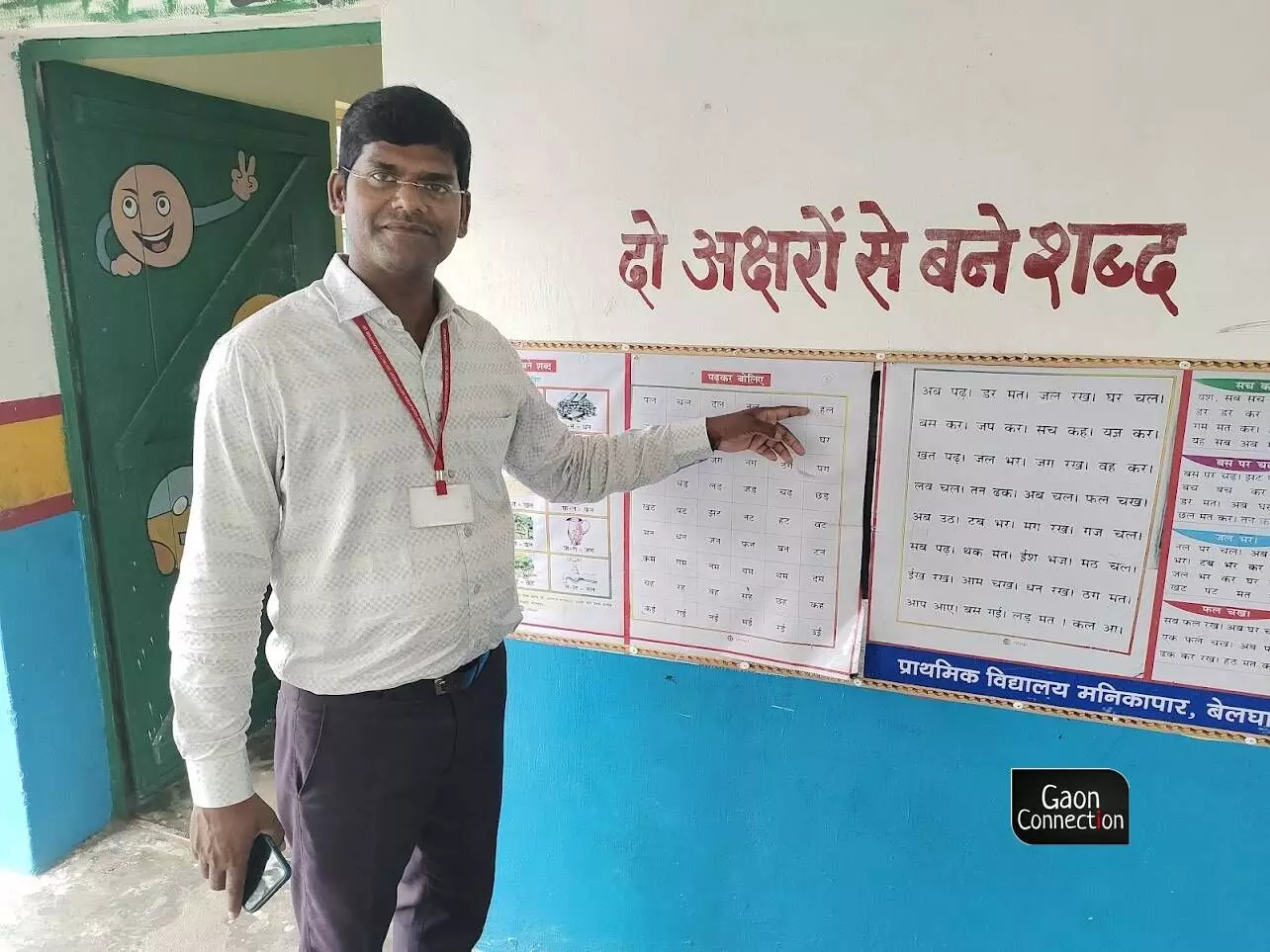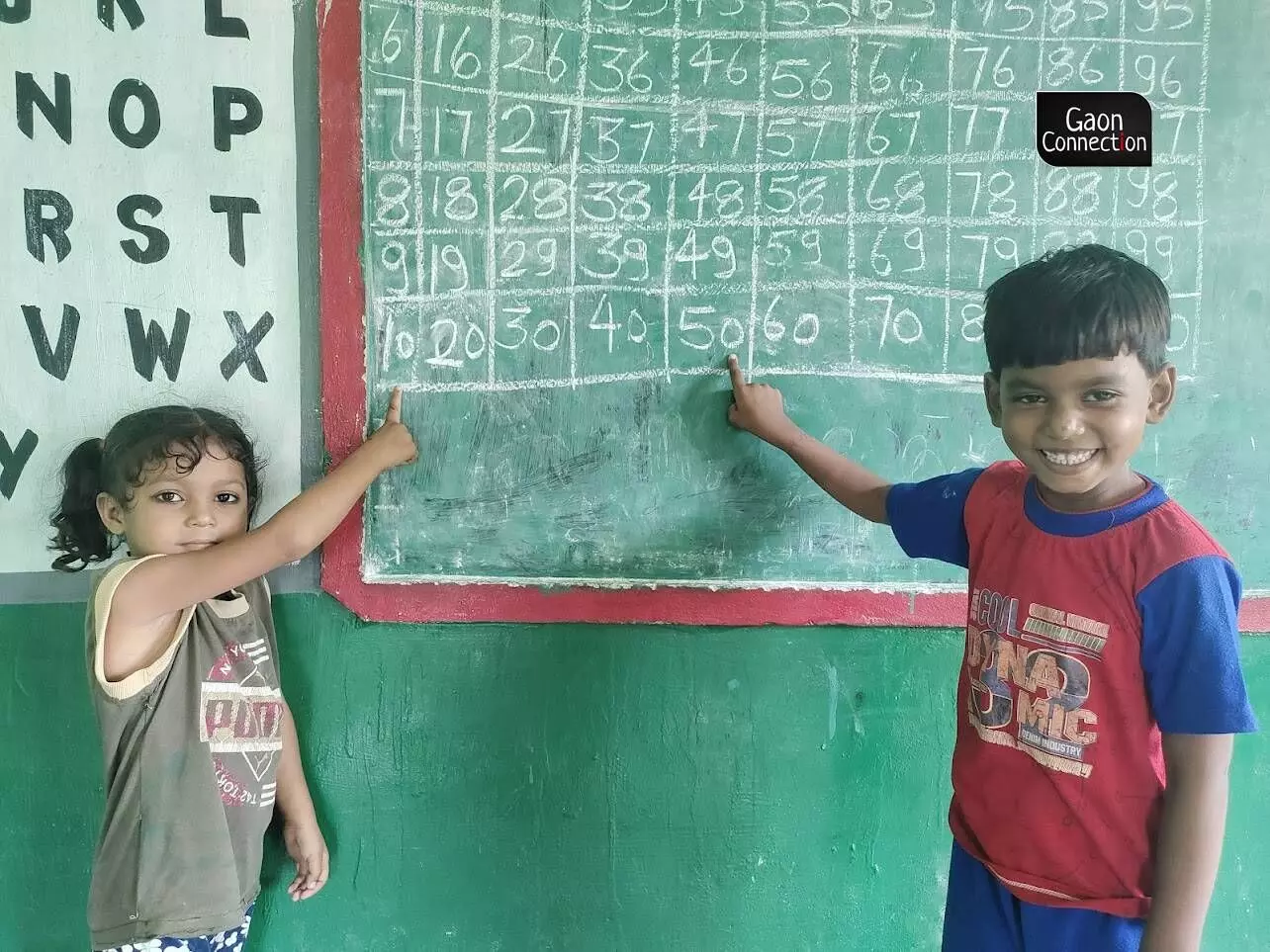Manikapar, Gorakhpur (Uttar Pradesh)
For Vijay Kumar Chaudhary, teaching students in the primary school is not merely an occupation but a calling. He lives in a room inside the school premises and likes nothing better than painting educational graffiti on the walls of the classrooms.
“The kids really like it. The graffiti adds colour to the classrooms but also acts as a teaching aid to the teachers who teach in it,” he told Gaon Connection. “Although I have a house in the city, I prefer to live here and spend time interacting with the villagers and beautifying the school,” Chaudhary said.
The 44-year-old teacher was posted as an assistant teacher at the school in 2010 and is now its headmaster. He presently teaches classes one and five.
Anshika, one of his students, perks up as he asks her to tell the story of an injured dog that a little girl takes home and looks after. There is a poster on the wall on which is a pictorial depiction of the dog and the little girl, and Anshika looks at it and confidently narrates the story to her classmates.
Also Read: Keeping students on the right track

Chaudhary is big on pictorial presentations. He uses posters, and the graffiti of the wall and firmly believes the children benefit from this.
As part of the NIPUN (National Initiative for Proficiency in Reading with Understanding and Numeracy) programme launched by the Union Ministry of Education, in July 2021, teachers are encouraged to use visual aid in teaching students in class one. Teacher guides provided by the state government guide the teachers on how to go about this.
Chaudhary believes that happy children are receptive children and therefore it is the duty of the teachers to make sure they are happy in school.
Also Read: What Did You Eat For Breakfast? — A Simple Question Helped A Teacher Retain Students In School
“Happiness is extremely important. It is fundamental to a child’s perception about school. If a child isn’t happy with what heshe is doing in school, no amount of hard work by the teacher will bear results,” he said.
Anshika, one of Chaudhary’s students, said she spends a lot of time looking at the graffiti on her school walls. “The walls of the school are very pretty. Studying becomes interesting because of these paintings,” she said.

Chaudhary is big on pictorial presentations. He uses posters, and the graffiti of the wall and firmly believes the children benefit from this.
Graffiti inspires students to speak up
The teachers use the graffiti clad walls as teaching aids. They ask their students questions about what is painted on the walls.
When Chaudhary asked Ritik to point towards his favourite vegetable, he pointed to the pumpkin. This was followed by a conversation around the vegetable.
Ritik proceeded to inform his classmates that he had pumpkin along with poori, paratha, roti and sometimes rice.
Also Read: Conversations in the classroom
These are the exchanges that improve the fluency of the children and encourage them to speak freely, Chaudhary said. “We start with questions that require just a word or two in answer, then gradually graduate to questions that require the students to speak longer sentences and use more words,” he explained.
“It helps them feel confident. This confidence goes a long way in in making their learning process so much smoother,” he said.

The parents of the students are happy that their children are being cared for so much by the staff in the school.
Meals of choice
The students also have a say in what they will eat that day at the school. “We ask the cooks to prepare the meal which students say they want to eat,’ Chaudhary said.
For Riya, it would be soya sabzi [soya nuggets] that she votes for every time she is asked what she wants to eat that day.
“It makes them feel involved in the school. Children like to come to a place where they are heard and their choices are respected. This keeps the dropout rates in check and also increases attendance,” he said.
The parents of the students are happy that their children are being cared for so much by the staff in the school.
“My daughter has become so confident in just two months since she joined this school. She is excited to go to school every day. She loves the paintings on the walls and how much her teachers care for her,” Roopvati, a parent of one of the students, told Gaon Connection.
“I am thankful to the teacher who teaches here. He lives here and has also painted the walls of the school which has made it very attractive for the students. I feel that my child is getting the right education here,” she told Gaon Connection.


















